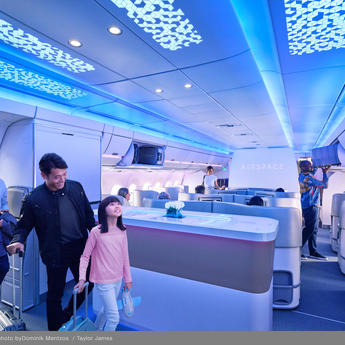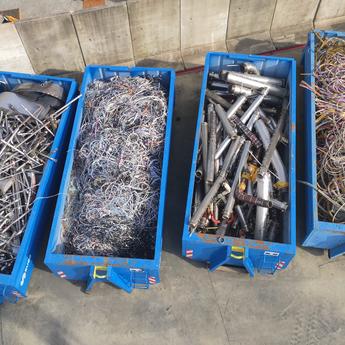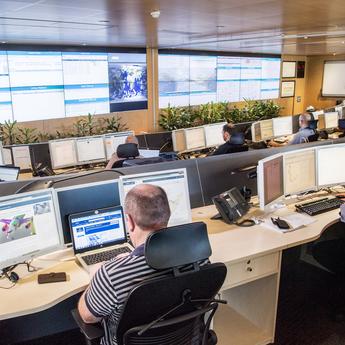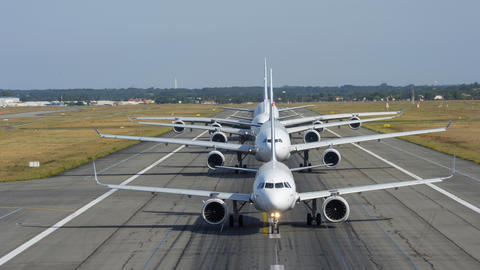Exceptional, pandemic-related circumstances meant Airbus had to think much faster and find creative work-arounds to continue supporting customers. There was a real push to adapt and be flexible.
As airlines return, or prepare to return to service, FAST talks to Programmes and Services about recent developments and what’s coming up in the future for customers.
Interview with Florent Massou, formerly HO A220 Programme*
*Now HO Wide Body End to End Integration, F. Massou has been replaced by D. Wenninger
-
Is it true that the A220 performed remarkably well during 2020?
The answer is an overwhelming yes! Even though this is the worst crisis that aviation has faced, we have seen customers continue to fly their A220 aircraft, chiefly because of the low operating costs and high versatility. The A220 was actually the most active fleet in its segment during the crisis - with a minimum of 50% of the fleet in service at the lowest point of the crisis. All aircraft had returned to operation over the summer of 2020. At the end of 2020, following another grounding period, the A220 fleet had fully recovered to pre-crisis level.
-
What are some of the highlights regarding A220 customers?
We are proud to have welcomed new customers during the pandemic, with first-time deliveries to JetBlue, Air Austral and Air France, to name but a few. Delta was the first customer to receive its A220 from the FAL in Mobile Alabama in October 2020, which comes in addition to the FAL in Mirabel, Quebec.
We launched the ACJ TwoTwenty in October 2020, with the first customer and interior outfitter Comlux. The ACJ is an extra large bizjet which features a signature flexible cabin catalogue based on the A220-100.
And with the A220 now featuring in the Toulouse Airspace Customer Showroom, signed customers can use the mock-up to configure their cabin, experimenting with seats, fabrics and lighting.
-
What about A220 programme developments and next steps?
In 2019, we announced that the MTOW of the A220 Family was increased by 5,000 lbs and the range by up to 450 nm. Earlier in 2021, we received the authorities’ approval for the A220-300 MTOW for 156,300 lbs - which is higher than expected. So, good news!
The increased MTOW will enable more range on the A220-300, adding additional flexibility for customers with higher payload configurations, for example, enabling higher-density configurations or increased cabin options.
We are now focussed on 3 main challenges: firstly, improving in-service performance to ensure that we remain the benchmark in the market. This includes the maturity of the aircraft in service and supporting our customers via the parts availability provided by Satair, in place since mid-2020. Next, we must increase our production rate and support our supply chain towards an increased production rate, going up to rate 14 in the coming years. Finally, we need to keep on improving the profitability of the programme which we do through activities to lower the aircraft production cost, while ensuring the same level of quality upon delivery and in-service.
Interview with Michael Menking, HO A320 Programme
-
What change during the pandemic has made a real difference to customers?
In April 2020, we delivered the very first 100% “e-delivered” aircraft. This was a most rewarding moment that not only made a positive difference to the customer experience, but also showed teamwork, agility and innovation.
As well as affording a means of safe business continuity during the COVID-19 crisis the e-Delivery process, with its new collaborative digital aspects, confers enhanced workflow efficiencies, flexibility, transparency, plus a more environmentally-friendly and smoother overall customer experience. It then became a blueprint for Airbus and customers and was extended across the different programmes.
-
Has the development of the A321XLR been impacted by the pandemic?
Keeping the A321XLR programme development on time whilst the whole world was hit by the health crisis and its social and economic consequences was a priority. We succeeded together with our suppliers and our teams worldwide, and I am proud to say that the A321XLR is on track for entering into service in 2023.
One of the key factors has been the robust industrial set up with the implementation of the Pilot Line, enabling ramp-up of the A321XLR’s fuselages without impacting the existing A320 Family production operations. Designed in 3D, the Pilot Line allows the perfect integration of the A321XLR design data from the beginning. Also part of the seamless XLR development has been the use of digital and full-size demonstrators, de-risking the route to flight clearance and serial manufacturing. These demonstrators have played a major role in validating all the design work and assembly processes and in ensuring that parts are fully prepared for manufacturing.
Interview with Patrick Piedrafita, HO Widebody Programme
-
Despite a challenging couple of years, can you tell us about some of the positive news for the A350 Family?
The A350 found a new role as some customers decided to convert their aircraft to carry cargo rather than passengers. The aircraft has proven to be particularly practical in a cargo configuration thanks to its cabin space, its fully flat, horizontal floor and its recessed rails. These “preighters” have already transported tonnes of equipment, industrial products and goods.
Airbus is strongly committed to sustainable solutions so it was great news to resume emission test flights of an A350 using 100% sustainable aviation fuels (SAF). These ongoing tests are part of a series to further develop SAF in aviation.
Customers can now choose to receive delivery of their A350s from the Airbus Completion and Delivery Centre (C&DC) in Tianjin, China. This additional option builds on our long-term collaboration with China which started over 30 years ago.
And finally, a new freighter is coming to the market! We officially launched the A350F freighter derivative at the Dubai airshow in November 2021 and currently have two orders for 11 aircraft and 2 letters of intent for 11 more. Entry into service is planned in 2025.
-
What are some of the latest developments in the A330 Family?
In 2020 we received the type certification for our A330-800 which we were then delighted to deliver to customers Kuwait Airways and Uganda airlines.
We also certified the A330-900 251-tonne weight variant and are in the process of certifying the A330-800 251-tonne version enabling greater capability. Meanwhile, we are expecting to announce the new certification for the A330-900 which will bring an increase in capacity to 459 passengers.
Again in line with our sustainability focus, last May we were proud the A330-900 became the first commercial aircraft world-wide to be certified by EASA for ICAO’s new CO2 emissions standard, in compliance with foreseeable CO2 regulations.
-
What does the situation look like today for widebody operators?
The widebody programme has certainly been badly hit throughout the crisis with long-haul flights suspended and we are not yet back to normal. Our initial concern was to support our customers in this difficult time and we adapted our production rates to cope with new delivery plans.
Today, we are ready to move ahead and have planned to increase production rates for both aircraft types to meet customer demand. This demand is already visible in the 25 A330 orders already made in 2021. We confirm a 50% ramp-up in production on the A330 for the end of November 2022.
Furthermore, we are working with operators to analyse how to optimise their current and future widebody fleets to maximise operational efficiency as they emerge from the crisis.
Interview with Pierre-Henri Brousse, HO Fleet Efficiency, Customer Services
-
Returning to service after such an extraordinary pause in operations is quite a challenge for customers. What have you been doing to help them?
Covid has taught us some lessons and created even bigger needs for adaptability and reactiveness in terms of aircraft support. We need to think more like our customers.
The first challenge for customers during the lock-downs was how to manage their grounded aircraft. Standard maintenance procedures exist of course for short-term parking and longer-term storing aircraft. However, the sheer quantity of grounded aircraft called for adapted measures such as extending inspection times whilst protecting airworthiness (see Parking & Storage - FAST article).
We also took a close look at our training offers to develop remote/virtual solutions. It was important for pilots and mechanics to maintain and refresh their qualifications and competences even during travel restrictions, in readiness for a return to service.
With 82% of the Airbus fleet in operation or parked in flying condition (as of 30 November 2021), adapting services to support customers and contribute to the industry’s resilience is key. This covers maintenance guidelines and programmes, including reinforced cleaning procedures, more flexible services such as Flight Hour Services (FHS) components-on-demand and different aircraft usage/aircraft versatility such as carrying cargo in the cabin.
-
What’s new or coming soon for customers?
We accelerated the Airbus Customer Care Centre project, which has now gone live. This is an enhanced version of our 24/hour AOG centre, with a reinforced team from Engineering and Customer Services. The team works very closely together to offer higher reactivity and quicker, easier-to-implement solutions to operators to prevent and resolve in-service incidents.
The in-service fleet support includes 3 types of support:
-
Reactive support: providing solutions to in-service issues encountered by operators and MROs such as AOG situations, operational and maintenance queries not already covered by technical documentation
-
Corrective support: providing fleet-wide solutions to increase fleet efficiency based on customer in-service feedback. This may then lead to service bulletins.
-
Anticipation support: preventing operational disruptions based on predictive models using in-service data. This can result in pre-defined solutions provided in advance, and technical documentation updates.
With this new set-up, we are reinforcing the ‘extended enterprise’ customer mindset and increasing collaboration efficiency. Meanwhile, using new technologies will help reduce incidents and increase our reactivity.
The crisis has put an enormous strain on the whole of the aviation industry. At the same time, it has pushed Airbus to become faster, more creative and more flexible in what it does and how it does it.
Progress has been made despite the challenging work conditions, bringing customers new aircraft capabilities for greater flexibility, the Customer Care Centre for reinforced support, and a robust industrial system to meet demand. Airbus is also investing in the post-crisis and future era by modernising its industrial system. This will bring greater industrial and production flexibility.
And projects to fly into the future include developing sustainability initiatives (Sustainable Aviation Fuel for the different families and the BelugaXL), and major programmes such as the A321XLR and the A350 Freighter.
Photo copyright Airbus. Airbus photographers: B. Król, L. Borrel, S. Ramadier. Master Films photographers : P. Pigeyre, F. Lancelot, A. Doumenjou
Latest FAST articles
Continue Reading

Getting ready for A350 cabin retrofits
Web Story
FAST
The first A350s are reaching eight years in service, and the wave of cabin retrofits which is now starting will rapidly gain momentum over the next few yea
Turbulence alert - The collaborative network
Web Story
FAST
Intermittent repetitive failure
Web Story
FAST

End-of-life Reusing, recycling, rethinking
Web Story
FAST

In-flight health monitoring
Web Story
FAST

